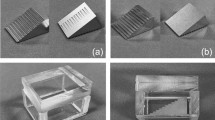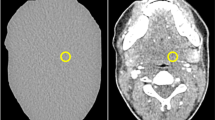Abstract
Objectives
(1) We sought to assess correlation among four representative parameters from a cluster signal-to-noise curve (true-positive rate [TPR] corresponding to background noise, accuracy corresponding to background noise, maximum TPR, and maximum accuracy) and the diagnostic accuracy of the identification of the mandibular canal using data from observers in a previous study, under the same exposure conditions. (2) We sought to clarify the relationship between the hole depths of a phantom and diagnostic accuracy.
Methods
CBCT images of a Teflon plate phantom with holes of decreasing depths from 0.7 to 0.1 mm were analyzed using the FindFoci plugin of ImageJ. Subsequently, we constructed cluster signal-to-noise curves by plotting TPRs against false-positive rates. The four parameters were assessed by comparing with the diagnostic accuracy calculated from the observers. To analyze image contrast ranges related to detection of mandibular canals, we determined five ranges of hole depths, to represent different contrast ranges—0.1–0.7, 0.1–0.5, 0.2–0.6, 0.2–0.7 and 0.3–0.7 mm—and compared them with observers’ diagnostic accuracy.
Results
Among the four representative parameters, accuracy corresponding to background noise had the highest correlation with the observers’ diagnostic accuracy. Hole depths of 0.3–0.7 and 0.1–0.7 mm had the highest correlation with observers’ diagnostic accuracy in mandibles with distinct and indistinct mandibular canals, respectively.
Conclusions
The accuracy corresponding to background noise obtained from the cluster signal-to-noise curve can be used to evaluate the effects of exposure conditions on diagnostic accuracy.







Similar content being viewed by others
References
Yoshiura K. Image quality assessment of digital intraoral radiography—perception to caries diagnosis. Jpn Dent Sci Rev. 2012;48:42–7.
Yoshiura K, Kanda S, Welander U. Theoretical consideration of radiological caries diagnosis: correlation between physical properties and diagnostic accuracy. Dent Jpn. 2005;41:101–6.
Yoshiura K, Okamura K, Tokumori K, Nakayama E, Chikui T, Goto TK, et al. Correlation between diagnostic accuracy and perceptibility. Dentomaxillofac Radiol. 2005;34:350–2.
Mansson LG. Methods for the evaluation of image quality: a review. Radiat Prot Dosimetry. 2000;90:89–99.
Weerawanich W, Shimizu M, Takeshita Y, Okamura K, Yoshida S, Yoshiura K. Cluster signal-to-noise analysis for evaluation of the information content in an image. Dentomaxillofac Radiol. 2018;47:20170147.
Kumar R, Indrayan A. Receiver operating characteristic (ROC) curve for medical researchers. Indian Pediatr. 2011;48:277–87.
Zou KH, O’Malley AJ, Mauri L. Receiver-operating characteristic analysis for evaluating diagnostic tests and predictive models. Circulation. 2007;115:654–7.
Jasa GR, Shimizu M, Okamura K, Tokumori K, Takeshita Y, Weerawanich W, et al. Effects of exposure parameters and slice thickness on detecting clear and unclear mandibular canals using cone beam CT. Dentomaxillofac Radiol. 2017;46:20160315.
Herbert A. ImageJ FindFoci plugins [Internet]. Brighton: University of Sussex; 2016. http://www.sussex.ac.uk/gdsc/intranet/pdfs/FindFoci.pdf. Accessed 2 Feb 2018.
Takeshita Y, Shimizu M, Okamura K, Yoshida S, Weerawanich W, Tokumori K, et al. A new method to evaluate image quality of CBCT images quantitatively without observers. Dentomaxillofac Radiol. 2017;46:20160331.
Flach PA. The Geometry of ROC Space: understanding machine learning metrics through ROC isometrics. In: Fawcett T, Mishra N, editors. Proceedings of the 20th International Conference on Machine Learning (ICML-2003); 2003 August 21–24; Washington DC, USA. California: The AAAI Press; 2003. p. 194–201.
Pauwels R, Silkosessak O, Jacobs R, Bogaerts R, Bosmans H, Panmekiate S. A pragmatic approach to determine the optimal kVp in cone beam CT: balancing contrast-to-noise ratio and radiation dose. Dentomaxillofac Radiol. 2014;43:20140059.
Pauwels R, Beinsberger J, Stamatakis H, Tsiklakis K, Walker A, Bosmans H, et al. Comparison of spatial and contrast resolution for cone-beam computed tomography scanners. Oral Surg Oral Med Oral Pathol Oral Radiol. 2012;114:127–35.
Acknowledgements
This work was supported by JSPS KAKENHI under Grant Number 15K11074.
Author information
Authors and Affiliations
Corresponding author
Ethics declarations
Conflict of interest
Warangkana Weerawanich, Yohei Takeshita, Shoko Yoshida and Gainer R Jasa declare that they have no conflict of interest. Mayumi Shimizu, Kazutoshi Okamura and Kazunori Yoshiura have received Grants from Japan Society for the Promotion of Science (15K11074).
Human and animal right statements
This article does not contain any studies with human or animal subjects performed by any of the authors.
Rights and permissions
About this article
Cite this article
Weerawanich, W., Shimizu, M., Takeshita, Y. et al. Evaluation of cone-beam computed tomography diagnostic image quality using cluster signal-to-noise analysis. Oral Radiol 35, 59–67 (2019). https://doi.org/10.1007/s11282-018-0325-0
Received:
Accepted:
Published:
Issue Date:
DOI: https://doi.org/10.1007/s11282-018-0325-0




